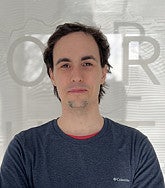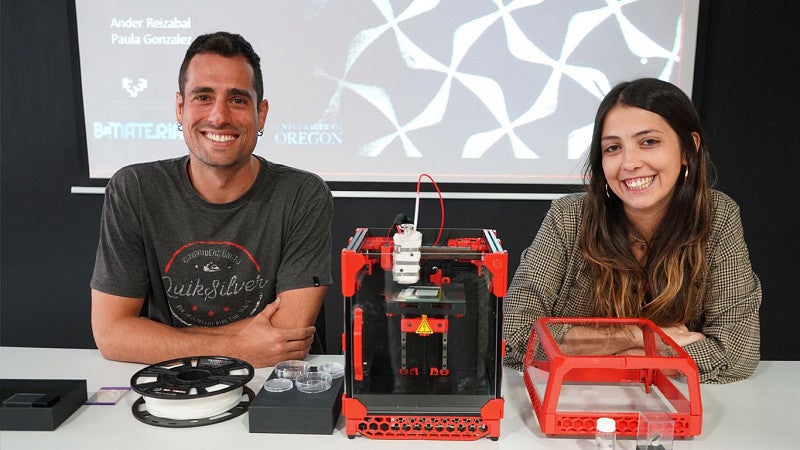
New research from the lab of professor Paul Dalton provides instruction plan for affordable, open-source microscale 3D printers, unlocking new possibilities in tissue engineering and biomaterial development
An advanced microscale 3D printing technology used for tissue engineering, cancer research and biofabrication is now accessible to researchers around the world. Described in the journal Additive Manufacturing, it is the work from the lab of melt electrowriting (MEW) pioneer Paul Dalton, a professor in the Department of Bioengineering at the Phil and Penny Knight Campus for Accelerating Scientific Impact.
Published in the June 5, 2023, edition of the journal, the paper has already made waves in the additive manufacturing field. It centers around MEW, a unique class of additive manufacturing invented by Dalton that enables the creation of high-resolution fibrous and porous structures using electrically charged molten polymers. The high cost of commercial MEW 3D printers, which can run upwards of $100,000, and the lack of standardized custom options have been a barrier to research progress in the field. The new paper provides a comprehensive instruction plan to convert a standard 3D printer into a viable bioengineering research printer for under $3,000 and could unlock new possibilities in tissue engineering and biomaterial development.

“Advanced manufacturing technologies should be available to all researchers,” Dalton said. “The project demonstrates how intellectual freedom drives innovation. How open-source hardware drives down costs and increases accessibility. We have a powerful tool for biomedical research and the fun is just beginning.”
The project was largely funded by Dalton’s startup funding from the Phil and Penny Knight Campus to Accelerate Scientific impact. His team of contributing Knight Campus researchers includes research engineer Simon Luposchainsky, visiting postdoctoral scholars Paula González Saiz and Ander Reizabal López-Para, and visiting scholars Sönke Menke and Taavet Kangur.

With the release of a modification to an open-source and low-cost 3D printer, much finer and complex scaffolds can be made, Dalton said. He credits Luposchainsky with one of the major innovations of the device: developing a filament-feed system for 3D printing, which opens broad access and allows researchers anywhere to produce new kinds of materials. Along with the filament-based feeding system, the team employed a conventional MEW pneumatic feeding system with a syringe reservoir. The converted filament MEWron configuration allows for precise control over flow rates, enabling the combination of different fiber diameters in high-resolution scaffolds. Whereas the syringe MEWron provides an affordable and easily modifiable platform for researchers interested in high-resolution structures.
In addition to Knight Campus researchers, the project involved researchers at the École Polytechnique Fédérale de Lausanne’s (EPFL) School of Engineering in Lausanne, Switzerland, and the University of the Basque Country’s Basque Center for Materials. Luposchainsky, a co-author on the paper, says the collaborative nature of the project paves the way toward accelerated research progress worldwide.
“We are kickstarting a global network of collaboration in the field of fiber 3D printing,” Luposchainsky said. “With this hardware, testing new approaches of 3D printing polymers at a micron-scale has never been easier.”
In creating the device, the team prioritized affordable and commercially available components. They converted a commercially available Fused Filament Fabrication (FFF) 3D printer kit, an open-source FFF Voron 0.1 printer, into a versatile melt electrowriting device that was dubbed the “MEWron”.

“Professor Dalton’s pioneering work in microscale 3D printing and his determination to translate scientific discoveries into widely available technologies is helping to pave the way toward future biomedical innovations,” said Robert Guldberg, vice president and Robert and Leona DeArmond Executive Director of the Knight Campus. "By making advanced manufacturing technologies accessible to all researchers, the Knight Campus is becoming a leader in biofabrication while enhancing research innovation conducted at the bench here in Oregon.”
International contributors on the project included Jürgen Brugger, head of Microsystems Laboratory (LMIS1); Professor Christophe Moser, head of Laboratory of Applied Photonics Devices (LAPD); and multiple students.
The project included a large educational and training effort, with EPFL robotics student Taavet Kangur and University of Würzburg biofabrication student Sönke Menke tackling the project as part of their master’s theses. Visiting post-doctoral scholars Paula González Saiz and Ander Reizabal López-Para from BCMaterials acquired both 3D printer assembly and operation skills with the new 3D printing technology and are bringing their know-how back to their home research institute.
— June 21, 2023
